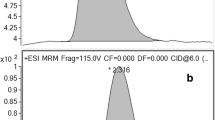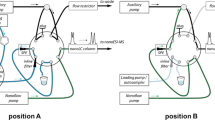Abstract
This work describes the characterization of a solid-phase extraction (SPE) and liquid-chromatography-tandem mass spectrometry-based method for the analysis of acrylamide (AA) in complex environmental waters. The method involved the SPE of AA using activated carbon, and the AA was detected with tandem mass spectrometry after separating on an ion exclusion high-performance liquid chromatography column. The method incorporated two labeled AA standards for quantification using isotope dilution and to assess absolute extraction recovery. The method was evaluated for inter- and intra-day precision and accuracy. The method was both accurate (i.e., <30 % error) and precise (i.e., <20 % relative standard deviation), with absolute extraction recoveries averaging 37 %. The mass spectrometry provided excellent sensitivity, with instrumental limits of detection and quantitation values of 23 and 75 pg, respectively. The method detection limit was determined to be 0.021 μg/L. The analysis of AA was successfully performed in real-world samples that contained total dissolved solids concentrations ranging from 23,600 to 297,000 mg/L and AA concentrations ranging from 0.082 to 1.0 μg/L.

Product ion spectra of, from top to bottom, acrylamide, acrylamide-1-13C, and acrylamide-2,3,3-d3. The predominant peak in each spectrum was used for quantitation


Similar content being viewed by others
Abbreviations
- AA:
-
Acrylamide
- AA-13C:
-
Acrylamide-1-13C
- AA-d3 :
-
Acrylamide-2,3,3-d3
- HPLC:
-
High-performance liquid chromatography
- LC-MS/MS:
-
Liquid chromatography-tandem mass spectrometry
- LOD:
-
Limit of detection
- LOQ:
-
Limit of quantitation
- MDL:
-
Method detection limit
- MRM:
-
Multiple reaction monitoring
- SPE:
-
Solid-phase extraction
- TDS:
-
Total dissolved solids
- TSS:
-
Total suspended solids
References
IPCS INCHEM (1985) International programme on chemical safety, environmental health criteria. http://www.inchem.org/documents/ehc/ehc/ehc49.htm. Accessed 18 Sept 2012
WHO (2011) Acrylamide in drinking-water: background document for development of WHO guidelines for drinking-water quality. http://www.who.int/water_sanitation_health/dwq/chemicals/acrylamide.pdf. Accessed 19 Sept 2012 2012
US EPA Consumer factsheet on: acrylamide. http://www.epa.gov/ogwdw/pdfs/factsheets/soc/acrylamide.pdf. Accessed 18 Sept 2012
IARC (1994) Monographs on the evaluation of carcinogenic risks to humans, vol 60. International Agency for Research on Cancer, Lyon, France
Report of the advisory group to recommend priorities for IARC Monographs during 2010-2014, Internal report 08/001. (2008) International Agency for Research on Cancer. http://monographs.iarc.fr/ENG/Publications/internrep/08-001.pdf. Accessed 19 Sept 2012
Tareke E, Rydberg P, Karlsson P, Eriksson S, Törnqvist M (2002) Analysis of acrylamide, a carcinogen formed in heated foodstuffs. J Agric Food Chem 50:4998–5006
US EPA (2012) Toxic release inventory (TRI) program. http://www.epa.gov/tri/. Accessed 19 Sept 2012
US EPA (1994) Method 8316: Acrylamide, acrylonitrile and acrolein by high performance liquid chromatography (HPLC). US Environmental Protection Agency. http://www.epa.gov/osw/hazard/testmethods/sw846/pdfs/8316.pdf. Accessed 19 Sept 2012
Weideborg M, Källqvist T, Odegård KE, Sverdrup LE, Vik EA (2001) Environmental risk assessment of acrylamide and methylolacrylamide from a grouting agent used in the tunnel construction of Romeriksporten, Norway. Water Res 35:2645–2652
Hashimoto A (1976) Improved method for the determination of acrylamide monomer in water by means of gas–liquid chromatography with an electron-capture detector. Analyst 101:932–938
US EPA (1996) Method 8032A: acrylamide by gas chromatography. US Environmental Protection Agency. http://www.epa.gov/epawaste/hazard/testmethods/sw846/pdfs/8032a.pdf. Accessed 19 Sept 2012
Cavalli S, Polesello S, Saccani G (2004) Determination of acrylamide in drinking water by large-volume direct injection and ion-exclusion chromatography-mass spectrometry. J Chromatogr A 1039:155–159
Marín JM, Pozo OJ, Sancho JV, Pitarch E, López FJ, Hernández F (2006) Study of different atmospheric-pressure interfaces for LC-MS/MS determination of acrylamide in water at sub-ppb levels. J Mass Spectrom 41:1041–1048. doi:10.1002/jms.1063
Rosén J, Nyman A, Hellenäs KE (2007) Retention studies of acrylamide for the design of a robust liquid chromatography-tandem mass spectrometry method for food analysis. J Chromatogr A 1172:19–24
Bermudo E, Moyano E, Puignou L, Galceran MT (2008) Liquid chromatography coupled to tandem mass spectrometry for the analysis of acrylamide in typical Spanish products. Talanta 76:389–394
Kawata K, Ibaraki T, Tanabe A, Yagoh H, Shinoda A, Suzuki H, Yasuhara A (2001) Gas chromatographic-mass spectrometric determination of hydrophilic compounds in environmental water by solid-phase extraction with activated carbon fiber felt. J Chromatogr A 911:75–83
Lucentini L, Ferretti E, Veschetti E, Achene L, Turrio-Baldassarri L, Ottaviani M, Bogialli S (2009) Determination of low-level acrylamide in drinking water by liquid chromatography/tandem mass spectrometry. J AOAC Int 92:263–270
US EPA (1971) Method 160.1: residue, filterable (gravimetric, dried at 180 °C). Methods for the chemical analysis of water and wastes (MCAWW) (EPA/600/4-79/020)
US EPA (1971) Method 160.2: residue, non-filterable (gravimetric, dried at 103–105 °C). Methods for the chemical analysis of water and wastes (MCAWW) (EPA/600/4-79/020)
Glaser JA, Foerst DL, McKee GD, Quave SA, Budde WL (1981) Trace analyses for wastewaters. Environ Sci Technol 15:1426–1435
Chu S, Metcalfe CD (2007) Analysis of acrylamide in water using a coevaporation preparative step and isotope dilution liquid chromatography tandem mass spectrometry. Anal Chem 79:5093–5096
Zhang Y, Ren Y, Jiao J, Li D, Zhang Y (2011) Ultra high-performance liquid chromatography-tandem mass spectrometry for the simultaneous analysis of asparagine, sugars, and acrylamide in Maillard reactions. Anal Chem 83:3297–3304
Mastovska K, Lehotay SJ (2006) Rapid sample preparation method for LC-MS/MS or GC-MS analysis of acrylamide in various food matrices. J Agric Food Chem 54:7001–7008
ICH (1996) Q2(R1) Validation of analytical procedures: methodology. (CPMP/ICH281/95)
Hoenicke K, Gatermann R, Harder W, Hartig L (2004) Analysis of acrylamide in different foodstuffs using liquid chromatography-tandem mass spectrometry and gas chromatography-tandem mass spectrometry. Anal Chim Acta 520:207–215
Acknowledgments
The United States Environmental Protection Agency, through its Office of Research and Development, funded and managed the research described here. It has been subjected to the Agency’s peer and administrative review and has been approved for publication. Mention of trade names or commercial products in this paper does not constitute endorsement or recommendation by the EPA.
This information is distributed solely for the purpose of pre-dissemination peer review under applicable information quality guidelines. It has not been formally disseminated by EPA. It does not represent and should not be construed to represent any Agency determination or policy.
The authors thank Matt Landis (EPA) for collecting the samples.
Author information
Authors and Affiliations
Corresponding author
Rights and permissions
About this article
Cite this article
DeArmond, P.D., DiGoregorio, A.L. Characterization of liquid chromatography-tandem mass spectrometry method for the determination of acrylamide in complex environmental samples. Anal Bioanal Chem 405, 4159–4166 (2013). https://doi.org/10.1007/s00216-013-6822-4
Received:
Revised:
Accepted:
Published:
Issue Date:
DOI: https://doi.org/10.1007/s00216-013-6822-4




